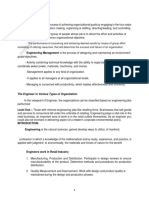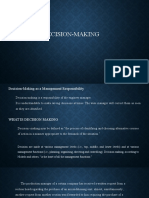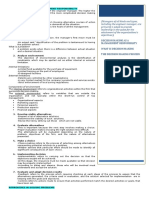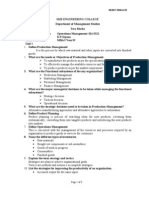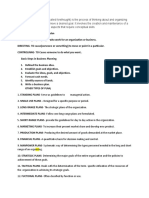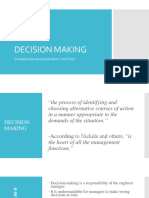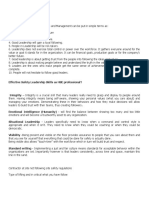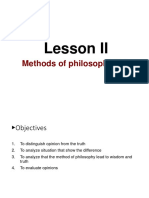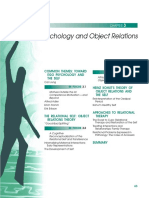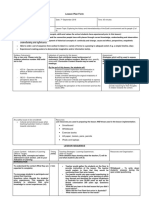© Joan R. Dimayuga, 2014 :))))))))))
ENGIMAN Engineering
- profession in which a knowledge of the mathematical and natural science gained by study, experience, and practice is applied with judgment to develop ways to utilize, economically, the materials and forces of nature for the benefit of mankind.
Management
- set of activities directed at an
organization’
s resources with the aim of achieving organizational goals in an efficient and effective manner. -
is a process consisting of
planning, organizing, directing (or leading), and controlling.
THE FUNCTIONS OF THE ENGINEER 1. Research
–
where the engineer is engaged in the process of learning about nature and codifying this knowledge into usable theories.
2. Design and development
–
where the engineer undertakes the activity of turning a product concept to a finished physical items.
3. Testing
–
where the engineer works in a unit where new products or parts are tested for workability.
4. Manufacturing
–
where the engineer is directly in charge of production personnel or assumes responsibility for the product.
5. Construction
–
this is where the construction engineer is directly in charge of the construction personnel or may have responsibility for the quality of the construction process.
6. Sales
-
where the engineer assists the company’s
customers to meet their needs, especially those that require technical expertise.
7. Consulting
–
where the engineer works as consultant of any individual or organization requiring his services.
8. Government
–
where the engineer may find employment in the government.
9. Teaching
–
where the engineer gets employment in a school and is assigned as a teacher of engineering courses.
10. Management
–
where the engineer is assigned to manage groups of people performing specific tasks.
THE ENGINEER IN VARIOUS TYPES OF ORGANIZATION 1. Level One
–
those with
minimal
engineering jobs like retailing firms.
2. Level Two
–
those with a
moderate
degree of engineering jobs like transportation companies
3. Level Three
–
those with a
high
degree of engineering jobs like construction firms.
Engineering management
-
refers to the activity
combining “
technical knowledge with the ability to organize and coordinate worker power, materials, machinery, and money
.”
REQUIREMENTS FOR THE ENGINEER MANAGERS JOB
1. a
bachelor’s degree i
n engineering
(or master’s
degree in engineering or business management is required ) 2.
few years experience in pure engineering job
3.
training in supervision
4.
special training in engineering management Kreitner
-
indicates at least three general preconditions for achieving lasting success as a manager.
1. Ability 2. Motivation to manage 3. Opportunity Managerial ability
- refers to the capacity of an engineer manager to achieve organizational objectives effectively and efficiently.
John B. Miner
- developed a psychometric instrument to
measure objectively an individual’s motivation to
manage.
OPPORTUNITY
–
two requirements:
obtaining a suitable managerial job
finding a supportive climate once on the job. FUNCTIONS
DECISION-MAKING
- process of identifying and choosing alternative courses of action in a manner appropriate to the demands of the situation.
-
“heart of all the management functions” according to Nickels
THE DECISION-MAKING PROCESS




© Joan R. Dimayuga, 2014 :)))))))))) According to
David H. Holt
, rational decision-making
involves the following steps”
1.
DIAGNOSE THE PROBLEM
- Identification of the problem is tantamount to having the problem half-solved.
2.
ANALYZE THE ENVIRONMENT
- The objective of environmental analysis is the identification of constraints, which may be spelled out as either internal or external limitations.
COMPONENTS OF THE ENVIRONMENT:
Internal
–
refers to organizational activities within a firm that surrounds decision-making.
External
–
refers to variables that are outside the organization and not typically within the short-run control of top management.
3.
DEVELOP VIABLE ALTERNATIVES
–
problems may be solved by any of the solutions offered.
4.
EVALUATE ALTERNATIVES
- how the alternatives will be evaluated will depend on the nature of the problem, the objectives of the firm, and the nature of alternatives presented. -
Each alternative must be analyzed and evaluated in terms of its value, cost, and risk characteristics.
VALUE
–
refers to the benefits that can be expected
COST
–
refers to out-of-pocket costs, opportunity costs, and follow-on costs.
RISK CHARACTERISTICS
–
refer to the likelihood of achieving the goals of the alternatives.
5.
CHOICE MAKING
–
process of selecting alternatives representing potential solutions to a problem.
6.
IMPLEMENT DECISION Implementation
–
refers to carrying out the decision so that the objectives sought will be achieved.
7.
EVALUATE AND ADAPT DECISION RESULTS
Feedback
–
process which requires checking at each stage of the process.
Control
–
actions made to ensure that activities performed match the desired activities or goals that have been set.
APPROACHES IN SOLVING PROBLEMS 1.
Qualitative evaluation 2.
Quantitative evaluation QUALITATIVE EVALUATION
- Evaluation of alternatives using intuition and subjective judgment.
QUANTITATIVE EVALUATION
- Evaluation of alternatives using any technique in a group classified as rational and analytical.
QUANTITATIVE MODELS FOR DECISION MAKING
1.
INVENTORY MODELS
–
consist of several types all designed to help the engineer manager make decisions regarding inventory. a.
ECONOMIC ORDER QUANTITY MODEL
–
used to calculate the number of items that should be ordered at one time to minimize the total yearly cost of placing orders and carrying the items in inventory. b.
PRODUCTION ORDER QUANTITY MODEL
–
economic order quantity technique applied to production orders. c.
BACK ORDER INVENTORY MODEL
–
used for planned shortages. d.
QUANTITY DISCOUNT MODEL
–
used to minimize the total cost when quantity discounts are offered by suppliers. 2.
QUEUING THEORY
–
describes how to determine the number of service unit that will minimize both customer waiting time and cost of service. 3.
NETWORK MODELS
–
models where large complex tasks are broken into smaller segments that can be managed independently. a.
The Program Evaluation Review Technique (PERT)
–
enables engineer managers to schedule, monitor, and control large and complex projects by employing three time estimates for each activity. b.
The Critical Path Method (CPM)
–
uses only one time factor per activity that enables engineer managers to schedule, monitor and control large and complex projects. 4.
FORECASTING
–
the collection of past and current information to make predictions about the future. 5.
REGRESSION ANALYSIS
- Forecasting method that examines the association between two or more variables.
© Joan R. Dimayuga, 2014 :))))))))))
SIMPLE REGRESSION
: one independent variable is involved
MULTIPLE REGRESSION
: two or more independent variables are involved. 6.
SIMULATION
–
represents reality, on which conclusions about real-life problems can be used. Decision maker develops a mathematical model of the system under consideration. 7.
LINEAR PROGRAMMING
–
used to produce an optimum solution within the bounds imposed by constraints upon the decision. 8.
SAMPLING THEORY
–
samples of populations are statistically determined to be used for a number of processes, such as quality control and marketing research. It saves time and money. 9.
STATISTICAL DECISION-THEORY
- Rational way to conceptualize, analyze, and solve problems in situations involving limited or partial information about the decision environment.
i.
PLANNING
–
involves anticipating future trends and determining the best strategies and tactics to achieve organizational objectives.
PLAN
–
provides a methodical way of achieving desired results
Planning at various management levels
1.
Top management level
–
strategic planning 2.
Middle management level
–
intermediate planning 3.
Lower management level
–
operational planning
STRATEGIC PLANNING
- process of determining the major goals of the organization and the policies and strategies for obtaining and using resources to achieve these goals.
Strategic plan
–
the output of strategic planning.
INTERMEDIATE PLANNING
- process of determining the contributions that sub-units can make with allocated resources; designed to support the strategic plan.
OPERATIONAL PLANNING
- process of determining how specific tasks can best accomplished on time with available resources.
Process of Planning 1.
Setting organizational, divisional or unit goals
- the first task of the engineer manager is to provide a sense of direction to his firm, to his division or to his unit. The setting of goals provide an answer to the said concern.
GOALS
–
precise statement of results sought, quantified in time and magnitude, where possible.
2.
Developing strategies or tactics to reach goals
STRATEGY
–
way to realize the goals; course of action aimed at ensuring that the organization will achieve its objectives.
Tactic
–
short term action taken by management to adjust negative internal or external influences. (*
tactical plan
)
3.
Determining resources needed
- when particular sets of strategies or tactics have been devised, the engineer manager will, then, determine the human and nonhuman resources required by such strategies or tactics.
4.
Setting standards
- the standards for measuring performance may be set at the planning stage.
Standard
–
a quantitative or qualitative measuring device designed to help monitor the performances of people, capital goods, or processes.
TYPES OF PLANS 1.
Functional Area Plans
Marketing plan
–
written document or blueprint for implementing and controlling
an organization’s marketing activities
related to a particular marketing strategy.
Production plan
–
states the quantity of output a company must produce in broad terms and by product family.
Financial plan
–
summarizes the current financial situation of the firm, analyzes financial needs, and recommends a direction for financial services.
Human resource management plan
–
indicates the human resource needs of a company detailed in terms of quantity and quality and based on the requirements of t
he company’s strategic plan.
2.
Plans With Time Horizons
© Joan R. Dimayuga, 2014 :))))))))))
Short-range plans
–
plans intended to cover a period of less than one year.
(first line supervisors)
Long-range plans
–
these are plans covering a time span of more than one year. (middle & top management)
3.
Plans According to Frequency of Use
Standing plans
- plans that are used again and again, and they focus on managerial situations that recur repeatedly.
i.
Policies
- broad guidelines to aid managers at every level in making decisions about recurring situations or function.
ii.
Procedures
–
they are plans that describe the exact series of actions to be taken in a given situation.
iii.
Rules
–
statements that either require or forbid a certain action.
Single-Use Plans
- specifically developed to implement courses of action that are relatively unique and are unlikely to be repeated.
i.
Budgets
–
sets forth the projected expenditure for a certain activity and explains where the required funds will come from.
ii.
Programs
–
designed to coordinate a large set of activities.
iii.
Projects
–
usually more limited in scope than a program and is sometimes prepared to support a program.
Parts of the Various Functional Area Plans
Contents of Marketing Plan (William Cohen) 1.
The executive summary
- presents an overall view of marketing project and its potential.
2.
Table of contents 3.
Situational analysis and target market 4.
Marketing objectives and goals 5.
Marketing strategies 6.
Marketing tactics 7.
Schedules and budgets 8.
Financial data and control
Contents of the Production Plan 1.
The amount of capacity the company must have 2.
How many employees are required 3.
How much material must be purchased
Contents of the Financial Plan 1.
An analysis of the firm’s current financial
condition as indicated by an analysis of the most recent statements. 2.
A sales forecast. 3.
The capital budget. 4.
The cash budget. 5.
A set of projected financial statements. 6.
The external financing plans.
Contents of human resources plan 1.
Personnel requirements of the company 2.
Plans for recruitment and selection 3.
Training plan 4.
Retirement plan
Parts of the Strategic Plan 1.
Company or corporate mission
–
strategic statement that identifies why an organization exists, its philosophy of management and its purpose as distinguished from other similar organizations in terms of products, services and markets.
2.
Objectives and Goals 3.
Strategies ii.
ORGANIZING
- structuring of resources and activities to accomplish objectives in an efficient and effective manner.
STRUCTURE
- arrangement or relationship of positions within an organization; result of the organizing process.
When structuring an organization, the engineer manager must be concerned with the following:
1.
Division of labor
- determining the scope of work and how it is combined in a job. 2.
Delegation of authority
- process of assigning various degrees of decision-making authority to subordinates









